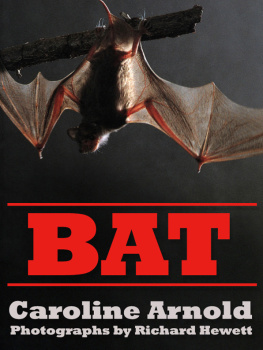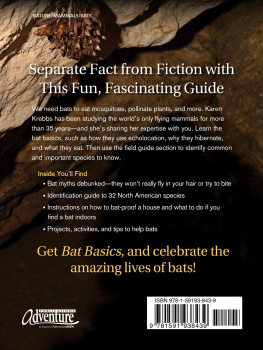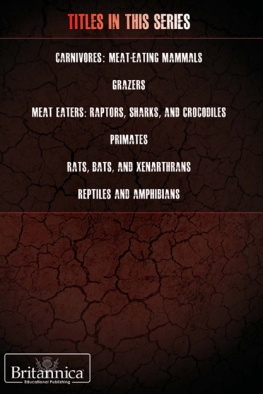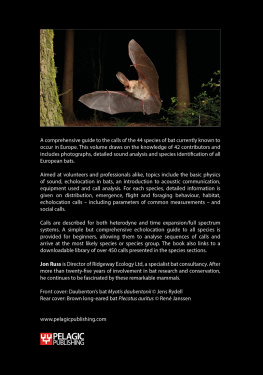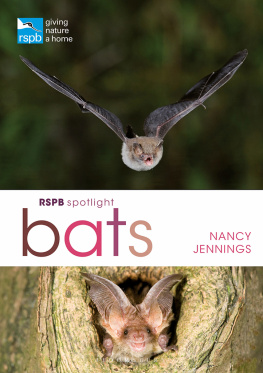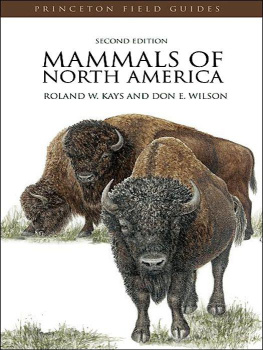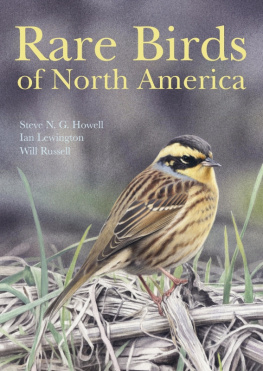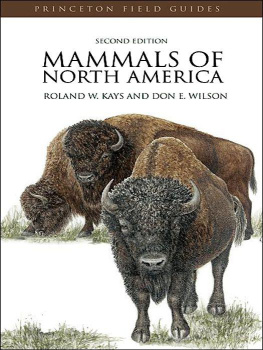BATS OF THE UNITED STATES AND CANADA
BATS of the United States and Canada

MICHAEL J. HARVEY, J. SCOTT ALTENBACH, AND TROY L. BEST

2011 THE JOHNS HOPKINS UNIVERSITY PRESS
All rights reserved. Published 2011
Printed in China on acid-free paper
9 8 7 6 5 4 3 2 1
The Johns Hopkins University Press
2715 North Charles Street
Baltimore, Maryland 21218-4363
www.press.jhu.edu
LIBRARY OF CONGRESS CATALOGING-IN-PUBLICATION DATA
Harvey, Michael J.
Bats of the United States and Canada / Michael J. Harvey, J. Scott Altenbach, and Troy L. Best.
p. cm.
Includes index.
ISBN-13: 978-1-4214-0191-1 (pbk.: alk. paper)
ISBN-10: 1-4214-0191-6 (pbk.: alk. paper)
1. BatsUnited States. 2. BatsCanada. I. Altenbach, J. Scott (Joe Scott) II. Best, Troy L. III. Title.
QL737.C5H383 2011
599.4dc22 2011004736
A catalog record for this book is available from the British Library.
Special discounts are available for bulk purchases of this book. For more information, please contact Special Sales at 410-516-6936 or specialsales@press.jhu.edu.
The Johns Hopkins University Press uses environmentally friendly book materials, including recycled text paper that is composed of at least 30 percent post-consumer waste, whenever possible.
CONTENTS
PREFACE
This book is an updated and expanded version of our 1999 booklet Bats of the United States, published by the Arkansas Game and Fish Commission in cooperation with the Asheville (North Carolina) Field Office of the U.S. Fish and Wildlife Service. Thousands of copies of that publication have been distributed. The primary goal of this (and that) publication is to provide readers with an accurate and concise source of information concerning life histories and conservation needs of this often misunderstood and unappreciated, yet fascinating and highly beneficial, group of animals.
Because all species of bats occurring in Canada (20) also are present in the United States (with 47 species), it was logical to include Canadian bats in this books title. In fact, information in some of the species accounts was taken from publications by Canadian scientists. Although Canada has less than half the number of species of bats found in the United States, there is a strong interest in biology of bats in Canada, and several Canadian biologists rank among the foremost bat researchers worldwide. Because the 47 species of bats in the United States and Canada account for less than 5% of the species of bats (more than 1,300) worldwide, we have also included some information concerning the biology of bats that occur in other parts of the world.
The combined careers of the authors of this book represent well over a century of research on bats. Dr. Michael J. Harvey, Professor Emeritus and an adjunct professor at Tennessee Technological University, has conducted research on bats primarily in the southeastern and south-central United States. Much of his research has involved ecology and conservation of endangered bats of that region. Dr. J. Scott Altenbach, Professor Emeritus at the University of New Mexico, has concentrated his research primarily on bats of the western United States. He is considered to be a leading expert in the use of abandoned mines by bats, as well as in mine safety. In addition to his conservation efforts, he is one of the worlds foremost photographers of bats. This book is greatly enhanced by his excellent photographs of all 47 species of bats occurring in the United States and Canada. Dr. Troy L. Best, a professor at Auburn University, has conducted research on bats largely in the southwestern and south-central United States and Mexico. His efforts have focused on ecology and conservation of bats.

Blanchard Springs Caverns in the OzarkSt. Francis National Forests, Arkansas, has been developed by the U.S. Forest Service as a tourist attraction. It serves as a hibernation site in winter and a bachelor roost site in summer for large colonies of endangered gray bats (Myotis grisescens). Michael J. Harvey
Bats in the United States and Canada, as well as worldwide, have suffered significant declines in recent years. In most cases, these declines have been the direct result of activities by humans. We hope this book will help convince the public that we must reverse these declines and thereby preserve this amazing group of animals for the enjoyment and benefit of future generations.
ACKNOWLEDGMENTS
We thank our respective universities (MJH, Tennessee Technological University; JSA, the University of New Mexico; TLB, Auburn University) for aid in making this publication possible. We are especially grateful to Robert R. Currie, U.S. Fish and Wildlife Service, and Keith B. Sutton, Arkansas Game and Fish Commission, for their financial and editorial help in making our 1999 publication possible. We also thank those many colleagues as well as numerous graduate and undergraduate students we have had the privilege of working with during our academic careers.
Because of the general nature of this publication, we have not cited or referenced the numerous authors and publications from which we obtained much of the information presented. To those scientists we owe a deep debt of gratitude. Without the use of the published results of their research, this book would not have been possible.
Finally, our very sincere thanks go to our families for their tolerance, patience, understanding, and support during our numerous nocturnal forays into the world of bats.
Night-vision binoculars and telescopes provide a means of observing bats in almost total darkness. J. Scott Altenbach

BATS OF THE UNITED STATES AND CANADA
INTRODUCTION
Bats are among the most misunderstood animals in the United States and Canada, as well as worldwide, although as consumers of enormous numbers of insects, they rank among the most beneficial. In other parts of the world, in addition to controlling insects, bats are extremely beneficial in dispersal of seeds and pollination of plants; numerous plants depend entirely on bats for these services.
Bats suffer from a bad public image in much of the world; misconceptions, myths, and superstitions about them abound. They are synonymous with symbols of doom and darkness, are considered to be close associates of Count Dracula, and various parts of their anatomy have been used as magical ingredients in witches brews (eye of newt and toe of frog, wool of bat and tongue of dog, Macbeth). Many people believe that bats are blind, try to become entangled in human hair, lay eggs, suck blood, are dirty and dangerous, or are flying mice (e.g., fledermaus, flying mouse in German; murcilago, mouse of the sky in Spanish; emya M, flying mouse in Russian). Idioms in various languages underscore the unsavory reputation of bats. They are associated with the netherworld (like a bat out of hell). And to describe people as batty, say they have bats in the belfry, or refer to someone as an old bat is less than complimentary. Books and movies such as
Next page

